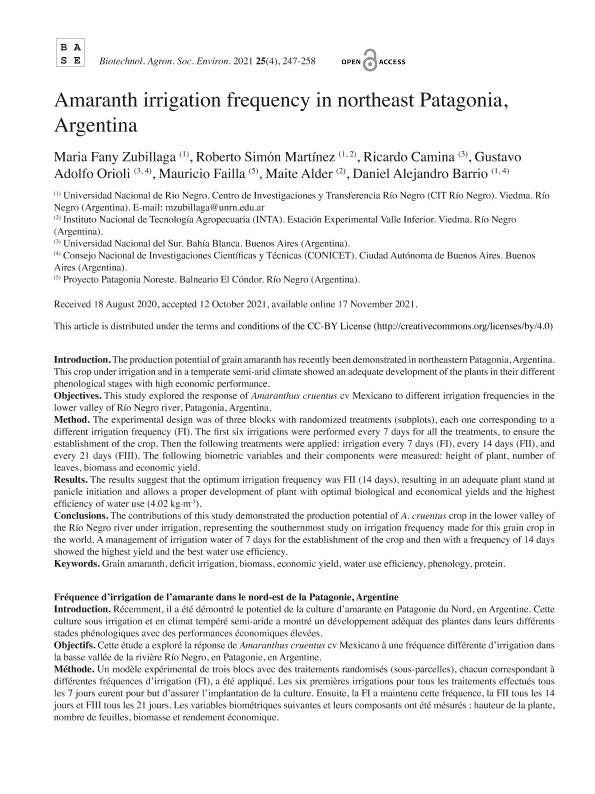Mostrar el registro sencillo del ítem
dc.contributor.author
Zubillaga, Maria Fany

dc.contributor.author
Martínez, Roberto Simón

dc.contributor.author
Camina, Ricardo
dc.contributor.author
Orioli, Gustavo Adolfo

dc.contributor.author
Failla, Mauricio
dc.contributor.author
Alder, Maite

dc.contributor.author
Barrio, Daniel Alejandro

dc.date.available
2023-09-29T18:12:01Z
dc.date.issued
2021-11
dc.identifier.citation
Zubillaga, Maria Fany; Martínez, Roberto Simón; Camina, Ricardo; Orioli, Gustavo Adolfo; Failla, Mauricio; et al.; Amaranth irrigation frequency in northeast Patagonia, Argentina; Fac Univ Sciences Agronomiques Gembloux; BIOTECHNOLOGIE, AGRONOMIE, SOCIéTé ET ENVIRONNEMENT; 25; 4; 11-2021; 247-258
dc.identifier.issn
1370-6233
dc.identifier.uri
http://hdl.handle.net/11336/213650
dc.description.abstract
Introduction. The production potential of grain amaranth has recently been demonstrated in northeastern Patagonia, Argentina. This crop under irrigation and in a temperate semi-arid climate showed an adequate development of the plants in their different phenological stages with high economic performance. Objectives. This study explored the response of Amaranthus cruentus cv Mexicano to different irrigation frequencies in the lower valley of Río Negro river, Patagonia, Argentina. Method. The experimental design was of three blocks with randomized treatments (subplots), each one corresponding to a different irrigation frequency (FI). The first six irrigations were performed every 7 days for all the treatments, to ensure the establishment of the crop. Then the following treatments were applied: irrigation every 7 days (FI), every 14 days (FII), and every 21 days (FIII). The following biometric variables and their components were measured: height of plant, number of leaves, biomass and economic yield. Results. The results suggest that the optimum irrigation frequency was FII (14 days), resulting in an adequate plant stand at panicle initiation and allows a proper development of plant with optimal biological and economical yields and the highest efficiency of water use (4.02 kg.m-3). Conclusions. The contributions of this study demonstrated the production potential of A. cruentus crop in the lower valley of the Río Negro river under irrigation, representing the southernmost study on irrigation frequency made for this grain crop in the world. A management of irrigation water of 7 days for the establishment of the crop and then with a frequency of 14 days showed the highest yield and the best water use efficiency.
dc.description.abstract
Introduction. Récemment, il a été démontré le potentiel de la culture d’amarante en Patagonie du Nord, en Argentine. Cette culture sous irrigation et en climat tempéré semi-aride a montré un développement adéquat des plantes dans leurs différents stades phénologiques avec des performances économiques élevées. Objectifs. Cette étude a exploré la réponse de Amaranthus cruentus cv Mexicano à une fréquence différente d’irrigation dans la basse vallée de la rivière Río Negro, en Patagonie, en Argentine. Méthode. Un modèle expérimental de trois blocs avec des traitements randomisés (sous-parcelles), chacun correspondant à différentes fréquences d’irrigation (FI), a été appliqué. Les six premières irrigations pour tous les traitements effectués tous les 7 jours eurent pour but d’assurer l’implantation de la culture. Ensuite, la FI a maintenu cette fréquence, la FII tous les 14 jours et FIII tous les 21 jours. Les variables biométriques suivantes et leurs composants ont été mésurés : hauteur de la plante, nombre de feuilles, biomasse et rendement économique. Résultats. Les résultats suggèrent que FII est la fréquence d’irrigation optimale. Cette fréquence d’irrigation génère un peuplement adéquat à l’initiation des panicules et permet un développement correct de la plante avec des rendements biologiques et économiques optimaux et la meilleure efficacité d’utilisation de l’eau (4,02 kg.m-3). Conclusions. Cette étude a démontré le potentiel de culture de A. cruentus dans la basse vallée de la rivière Río Negro, représentant l’étude de la densité d’installation réalisée pour cette culture de céréales la plus australe au monde. Une gestion de l’eau d’irrigation de 7 jours pour la mise en place de la culture puis avec une fréquence de 14 jours a montré le rendement le plus élevé et la meilleure efficacité d’utilisation de l’eau.
dc.format
application/pdf
dc.language.iso
eng
dc.publisher
Fac Univ Sciences Agronomiques Gembloux

dc.rights
info:eu-repo/semantics/openAccess
dc.rights.uri
https://creativecommons.org/licenses/by/2.5/ar/
dc.subject
BIOMASS
dc.subject
DEFICIT IRRIGATION
dc.subject
ECONOMIC YIELD
dc.subject
GRAIN AMARANTH
dc.subject
PHENOLOGY
dc.subject
PROTEIN
dc.subject
WATER USE EFFICIENCY
dc.subject.classification
Alimentos y Bebidas

dc.subject.classification
Otras Ingenierías y Tecnologías

dc.subject.classification
INGENIERÍAS Y TECNOLOGÍAS

dc.title
Amaranth irrigation frequency in northeast Patagonia, Argentina
dc.title
Fréquence d’irrigation de l’amarante dans le nord-est de la Patagonie, Argentine
dc.type
info:eu-repo/semantics/article
dc.type
info:ar-repo/semantics/artículo
dc.type
info:eu-repo/semantics/publishedVersion
dc.date.updated
2023-09-29T11:15:21Z
dc.identifier.eissn
1780-4507
dc.journal.volume
25
dc.journal.number
4
dc.journal.pagination
247-258
dc.journal.pais
Bélgica

dc.journal.ciudad
Gembloux
dc.description.fil
Fil: Zubillaga, Maria Fany. Consejo Nacional de Investigaciones Cientificas y Tecnicas. Centro de Investigaciones y Transferencia de Rio Negro. Sede Choele Choel del Centro de Investigaciones y Transferencia de Rio Negro | Universidad Nacional de Rio Negro. Centro de Investigaciones y Transferencia de Rio Negro. Sede Choele Choel del Centro de Investigaciones y Transferencia de Rio Negro.; Argentina
dc.description.fil
Fil: Martínez, Roberto Simón. Consejo Nacional de Investigaciones Cientificas y Tecnicas. Centro de Investigaciones y Transferencia de Rio Negro. Sede Choele Choel del Centro de Investigaciones y Transferencia de Rio Negro | Universidad Nacional de Rio Negro. Centro de Investigaciones y Transferencia de Rio Negro. Sede Choele Choel del Centro de Investigaciones y Transferencia de Rio Negro.; Argentina. Instituto Nacional de Tecnologia Agropecuaria. Centro Regional Patagonia Norte. Estacion Experimental Agropecuaria Valle Inferior del Río Negro.; Argentina
dc.description.fil
Fil: Camina, Ricardo. Universidad Nacional del Sur; Argentina
dc.description.fil
Fil: Orioli, Gustavo Adolfo. Consejo Nacional de Investigaciones Científicas y Técnicas; Argentina. Universidad Nacional del Sur; Argentina
dc.description.fil
Fil: Failla, Mauricio. Proyecto Patagonia Noreste; Argentina
dc.description.fil
Fil: Alder, Maite. Instituto Nacional de Tecnologia Agropecuaria. Centro Regional Patagonia Norte. Estacion Experimental Agropecuaria Valle Inferior del Río Negro.; Argentina
dc.description.fil
Fil: Barrio, Daniel Alejandro. Consejo Nacional de Investigaciones Cientificas y Tecnicas. Centro de Investigaciones y Transferencia de Rio Negro. Sede Choele Choel del Centro de Investigaciones y Transferencia de Rio Negro | Universidad Nacional de Rio Negro. Centro de Investigaciones y Transferencia de Rio Negro. Sede Choele Choel del Centro de Investigaciones y Transferencia de Rio Negro.; Argentina
dc.journal.title
BIOTECHNOLOGIE, AGRONOMIE, SOCIéTé ET ENVIRONNEMENT

dc.relation.alternativeid
info:eu-repo/semantics/altIdentifier/doi/http://dx.doi.org/10.25518/1780-4507.19310
dc.relation.alternativeid
info:eu-repo/semantics/altIdentifier/url/https://popups.uliege.be/1780-4507/index.php?id=19310
Archivos asociados
